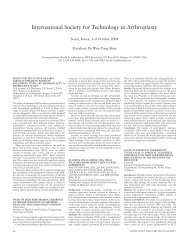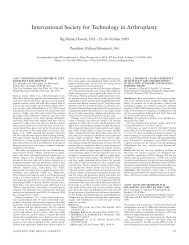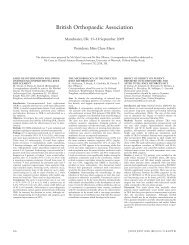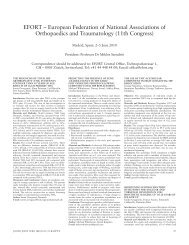Procs III 2011.indb - Journal of Bone & Joint Surgery, British Volume ...
Procs III 2011.indb - Journal of Bone & Joint Surgery, British Volume ...
Procs III 2011.indb - Journal of Bone & Joint Surgery, British Volume ...
Create successful ePaper yourself
Turn your PDF publications into a flip-book with our unique Google optimized e-Paper software.
370 HELLENIC ASSOCIATION OF ORTHOPAEDIC SURGERY AND TRAUMATOLOGY<br />
3 with CA. Conclusions: It appears that the immediate<br />
surgical intervention <strong>of</strong> patients with hip fracture has<br />
positive effect in the duration <strong>of</strong> hospitalization, morbidity<br />
and mortality<br />
162 ACETABULAR FRACTURES WITH<br />
MARGINAL IMPACTION: CLINICAL RESULTS<br />
P.V. Giannoudis, N.K. Kanakaris, P. Stavlas, V.S.<br />
Nikolaou, N. Prevezas<br />
Academic Department <strong>of</strong> Trauma and<br />
Orthopaedics, Leeds Teaching Hospitals,<br />
School <strong>of</strong> Medicine, University <strong>of</strong> Leeds, UK;<br />
Orthopaedic Department <strong>of</strong> General Hospital <strong>of</strong><br />
Nikea, Greece<br />
The purpose <strong>of</strong> this study was to investigate the outcome<br />
<strong>of</strong> acetabular fractures treated in our institution<br />
with marginal impaction.<br />
Over a 5 year period consecutive acetabular cases<br />
treated in our institution with marginal impaction were<br />
eligible for inclusion in this study. Exclusion criteria were<br />
patients lost to follow up and pathological fractures. A<br />
retrospective analysis <strong>of</strong> prospectively documented data<br />
was performed. Demographics, fracture types according<br />
to the Judet-Letournel classifi cation, radiological criteria<br />
<strong>of</strong> intra-operative reduction (Matta) and secondary<br />
collapse, complication rates, and the EuroQol-5D<br />
questionnaire were documented over a median period<br />
<strong>of</strong> follow-up <strong>of</strong> 40months (12-206).<br />
Out <strong>of</strong> 400 cases, eighty-eight acetabular fractures<br />
met the inclusion criteria. The majority (93.2%)<br />
involved males with a median age <strong>of</strong> 40.5years (16-80).<br />
Half <strong>of</strong> them were posterior-wall fractures, 21.6%bicolumn,<br />
14.7%posterior-wall and column, 6.8%transverse,<br />
5.7%anterior-column, 1.1%anterior-column posterior<br />
hemi-transverse. In 75% <strong>of</strong> the cases anatomical intraoperative<br />
reduction was achieved. Structural-bone-graft<br />
was used in 73.9%, and two-level reconstruction in<br />
61%. At the last follow-up, the originally achieved anatomical<br />
reduction was lost in 17/66 (25.8%), (10 PW,<br />
4 PC+PW, 1 PC, 1 Transverse, 1 Bicolumn fracture).<br />
Avascular necrosis developed in 9.1% and heterotopic<br />
ossifi cation in 19.3%. Full return to previous activities<br />
was documented in 48.9% <strong>of</strong> cases, the EuroQol general<br />
heath state score had a median <strong>of</strong> 80% (30-95%),<br />
full recovery was recorded as to the patients’ mobility in<br />
51.1%, as to pain in 47.7%, as to self-care in 70.5%,<br />
as to work-related activities in 55.7%, and as to emotional<br />
parameters in 65.9%. Reoperation (heterotopicossifi<br />
cation excision, total-hip-arthroplasty, removal <strong>of</strong><br />
metalwork) was necessary in 19.2% <strong>of</strong> cases.<br />
Utilising different techniques <strong>of</strong> elevation <strong>of</strong> the articular<br />
joint impaction leads to joint preservation with satisfactory<br />
overall functional results. Secondary collapse<br />
was noted in 25.8% <strong>of</strong> the patients predisposing to a<br />
poorer outcome<br />
163 MEDIUM TO LONG TERM RESULTS<br />
OF ACETABULAR RECONSTRUCTION<br />
FOLLOWING ANTERIOR COLUMN &<br />
ANTERIOR WALL FRACTURES<br />
N.K. Kanakaris, R.K. Mallina, P. Stavlas, G.<br />
Kontakis, P.V. Giannoudis<br />
Academic Department <strong>of</strong> Trauma and<br />
Orthopaedics, Leeds Teaching Hospitals, NHS<br />
Trust, Leeds, UK<br />
Anterior wall and/or column acetabular fractures (AW/<br />
C) have a low incidence rate. Paucity <strong>of</strong> information<br />
exists regarding the clinical results <strong>of</strong> these fractures.<br />
We present our experience in treating AW/C at a tertiary<br />
referral centre.<br />
Between Jan-2002 and Dec-2007, 200 consecutive<br />
patients were treated in our institution with displaced<br />
acetabular fractures. All AW/C fractures according to<br />
the Letournel classifi cation were included in the study.<br />
All patients underwent plain radiography and CT investigations.<br />
Retrospective analysis <strong>of</strong> the medical notes<br />
and radiographs was performed for type <strong>of</strong> associated<br />
injuries, operative technique, peri-operative complications.<br />
Radiological assessment <strong>of</strong> fracture healing was<br />
determined by Matta’s criteria and functional hip scores<br />
were assessed using Merle-d’-Aubigne scoring. The<br />
mean follow up was 44.5 months (28-64).<br />
15 patients (10 males) met the inclusion criteria<br />
(mean age 55.5years). Four had associated anterior dislocation.<br />
Associated injuries included pneumothorax,<br />
splenic rupture, tibial and distal radius fractures. Five<br />
were treated by percutaneous methods, 8 with platescrew<br />
fi xation, and 2 with circlage wire, (10 ilioinguinal<br />
approaches). Mean time-to-surgery was 14days(10-<br />
21days). The average operative time for the percutaneous<br />
group was 75min vs. 190min in the orif group.<br />
Mean postoperative-in-patient-stay was 4 days(3-<br />
7days), and 21days(14-37days). One patient developed<br />
chest infection post-operatively, two loss <strong>of</strong> sensation<br />
over the distribution <strong>of</strong> lateral cutaneous nerve. None <strong>of</strong><br />
them developed incisional hernia, deep venous thrombosis<br />
and pulmonary embolism. At the last follow-up<br />
radiological outcome was excellent in 11 and good in 4<br />
patients; clinical outcome was excellent in 12 and good<br />
in 3 patients, and none <strong>of</strong> the patients has developed<br />
heterotopic calcifi cation or early osteoarthritis.<br />
Our results on management <strong>of</strong> these fractures are comparable<br />
to the early results reported by Letournel. Operative<br />
treatment for the rare anterior wall and anterior<br />
column fractures yields a favourable outcome resulting in<br />
early mobilization with limited patient morbidity<br />
164 EFFECTIVENESS OF PHILOS PLATE IN<br />
TREATMENT OF HUMERUS PROXIMAL END<br />
FRACTURES<br />
E. Athanaselis, I. Gliatis, P. Bougas, M. Tyllianakis<br />
Orthopaedic Department, University Hospital <strong>of</strong><br />
Patras<br />
The study <strong>of</strong> effectiveness <strong>of</strong> PHILOS plate in the internal<br />
osteosynthesis <strong>of</strong> humeral head fractures.<br />
Since 2006 23 patients with 24 humeral head fractures<br />
ere treated in our clinic. 10 <strong>of</strong> them were men<br />
(43,48%) and 13 women (56,52%). The average age<br />
was 50,4 years (range 16-89 years). Fractures <strong>of</strong> the<br />
surgical neck <strong>of</strong> humerus were 8 <strong>of</strong> these (33,33%), 12<br />
were 3 parts fractures according to Neer classifi cation<br />
(50%) and fi nally in 3 cases there was a 4 part fracture<br />
(16,66%). Shoulder <strong>of</strong> dominant upper limb was<br />
injured in most <strong>of</strong> the cases (68%).<br />
19 patients (82,6%) were examined periodically in<br />
an average follow-up period <strong>of</strong> 19 months (range 13-<br />
26 months). All the fractures were healed. In 4 cases<br />
(16,66%) insuffi cient reduction was detected postoperatively.<br />
Constant score was calculated 12 months<br />
post-operatively up to 82,05 by mean (range 62-100).<br />
Differentiation was observed between the patients <strong>of</strong><br />
age less than 60 years (12 patients with average constant<br />
score 91,25 with range from 78 until 100) and these <strong>of</strong><br />
age <strong>of</strong> 60 years or more (7 patients with average constant<br />
score 71,43 with range from 62 until 81).<br />
Internal osteosynthesis humeral head fractures with<br />
PHILOS plate is a reliable method <strong>of</strong> treatment not only<br />
for simple head fractures but also for them <strong>of</strong> 3 or even<br />
4 parts, without complications and with very good functional<br />
results<br />
165 ATLS AND PELVIC RADIOGRAPHY<br />
GUIDELINES. HOW GOOD IS CLINICAL<br />
EXAMINATION COMPARED TO<br />
CONVENTIONAL RADIOGRAPHY?<br />
D.S. Evangelopoulos, M. Hilty, L.M. Benneker, H.<br />
Zimmermann and A.K. Exadaktylos<br />
Department <strong>of</strong> Orthopaedic <strong>Surgery</strong>, Inselspital,<br />
University <strong>of</strong> Bern, Switzerland; Department <strong>of</strong><br />
Emergency Medicine, Inselspital, University <strong>of</strong><br />
Bern, Switzerland<br />
Pelvic x-ray is a routine part <strong>of</strong> the primary survey <strong>of</strong><br />
Advanced Trauma Life Support (ATLS) guidelines. However,<br />
pelvic CT is the gold standard in the diagnosis <strong>of</strong><br />
pelvic fractures. This study aims to confi rm the safety<br />
<strong>of</strong> a modifi ed ATLS algorithm omitting pelvic x-ray in<br />
hemodynamically stable polytraumatized patients with<br />
clinically stable pelvis, in favour <strong>of</strong> later pelvic CT scan.<br />
A retrospective analysis <strong>of</strong> polytraumatized patients<br />
in our emergency room was conducted between 2005<br />
and 2006. Inclusion criteria were blunt abdominal<br />
trauma, initial hemodynamic stability and clinically<br />
stable pelvis. We excluded patients requiring immediate<br />
intervention.<br />
We reviewed the records <strong>of</strong> 452 patients. 91 fulfi lled<br />
inclusion criteria (56% male, mean age 45 years). 43%<br />
were road traffi c accidents and 47% falls. In 68/91<br />
(75%) patients, both pelvic x-ray and CT examination<br />
were performed; the remainder had only pelvic CT.<br />
In 6/68 (9%) patients, pelvic fracture was diagnosed<br />
by pelvic x-ray. None false positive pelvic x-ray was<br />
detected. In 3/68 (4%) cases a fracture was missed in<br />
the pelvic x-ray, but confi rmed on CT. 5 (56%) were<br />
classifi ed type A fractures, and another 4 (44%) B 2.1<br />
in computed tomography (AO classifi cation). One A<br />
2.1 fracture was found in a clinically stable patient who<br />
only received CT scan (1/23).<br />
In hemodynamically stable patients with clinically<br />
stable pelvis, x-ray sensitivity is only 67% and it may<br />
safely be omitted in favor <strong>of</strong> a pelvic CT examination.<br />
The results support the safety and utility <strong>of</strong> our modifi ed<br />
ATLS algorithm<br />
166 QUALITY OF LIFE AFTER TIBIAL<br />
PLATEAU FRACTURES<br />
E. Myriokefalitakis, K. Papanastasopoulos, Th.<br />
Krithymos, I. Giannoulias, K. Kateros, K. Sarantos<br />
A’ Orthopaedic Department, General Hospital <strong>of</strong><br />
Athens “G. Gennimatas”<br />
Tibial plateau fractures are common fractures which<br />
most <strong>of</strong> the times require surgery. Recovery can take<br />
several months. The aim <strong>of</strong> our study was to estimate<br />
the effect <strong>of</strong> tibial plateau fractures in quality <strong>of</strong> life <strong>of</strong><br />
patients one year after the surgery.<br />
During the time period 2004-2007 we treated 86<br />
patients, with a mean age <strong>of</strong> 44 years (23-68). Fracture<br />
classifi cation was according to Schatzker, hence, there were<br />
9 patients with type I, 14 with type II, 20 with type <strong>III</strong>, 22<br />
with type IV, 13 with type V and 8 with type VI. In 45<br />
(52.3%) patients the articular surface was reduced with<br />
limited use <strong>of</strong> internal fi xation and bone grafts, whereas<br />
the remaining patients had syndesmotaxis performed. In<br />
all patients stabilization was achieved with hybrid external<br />
fi xators. Sixty four patients returned in one year postoperative<br />
for the study, at which time they completed the<br />
Short Form-36 (SF-36) general health surveys.<br />
Compared to the standardized SF-36 categorical and<br />
aggregate scores there was no statistically signifi cant<br />
difference between the healthy age-matched population<br />
and young patients with Schatzker I, II, <strong>III</strong> and<br />
IV fractures. But in 16 patients over 40 years old with<br />
Schatzker V and VI fracture, SF-36 score was lower in<br />
all categories, despite that 13 <strong>of</strong> them had full or partial<br />
return to pre-injury levels <strong>of</strong> functioning<br />
We conclude that the age <strong>of</strong> patients and the complexity<br />
<strong>of</strong> tibial plateau fractures infl uence the quality <strong>of</strong><br />
their life one year post-operative<br />
167 USE OF ILIZAROV TYPE FIXATOR<br />
FOR SEVERELY COMMINUTED INTRA-<br />
ARTICULAR CALCANEAL FRACTURES.<br />
PRELIMINARY RESULTS<br />
Ch. Konstantoulakis, G. Grigorakis, C.<br />
Manimanakis, G. Poulios, V. Petroulakis<br />
Orthopaedic Department, Chania General<br />
Hospital<br />
We reviewed in retrospect the preliminary results <strong>of</strong><br />
ilizarov type fi xator for the treatment <strong>of</strong> severely comminuted<br />
calcaneal fractures.<br />
Between February 2006 and December 2008 we<br />
dealt with six severely comminuted calcaneal fractures<br />
in six patients. Two <strong>of</strong> which were open type Gustillo<br />
<strong>III</strong>a. Mean age was 43 years old(28-56 years old) two<br />
<strong>of</strong> which were female and four male. Preoperatively all<br />
fractures were checked by x-ray and computed tomography<br />
and were all rated as Sanders type IV. The open<br />
fractures were treated within 6 hours and the closed<br />
J BONE JOINT SURG [BR] 2011; 93-B:SUPP <strong>III</strong>








